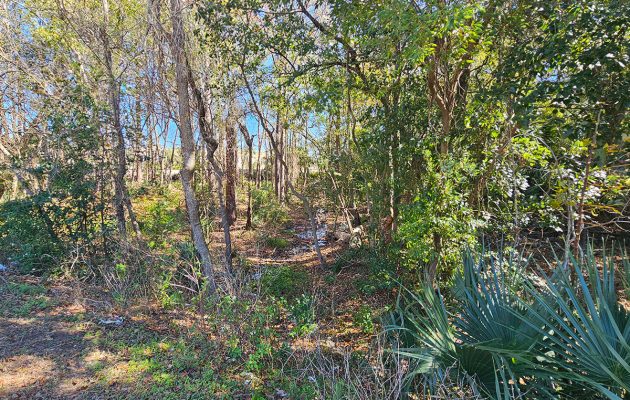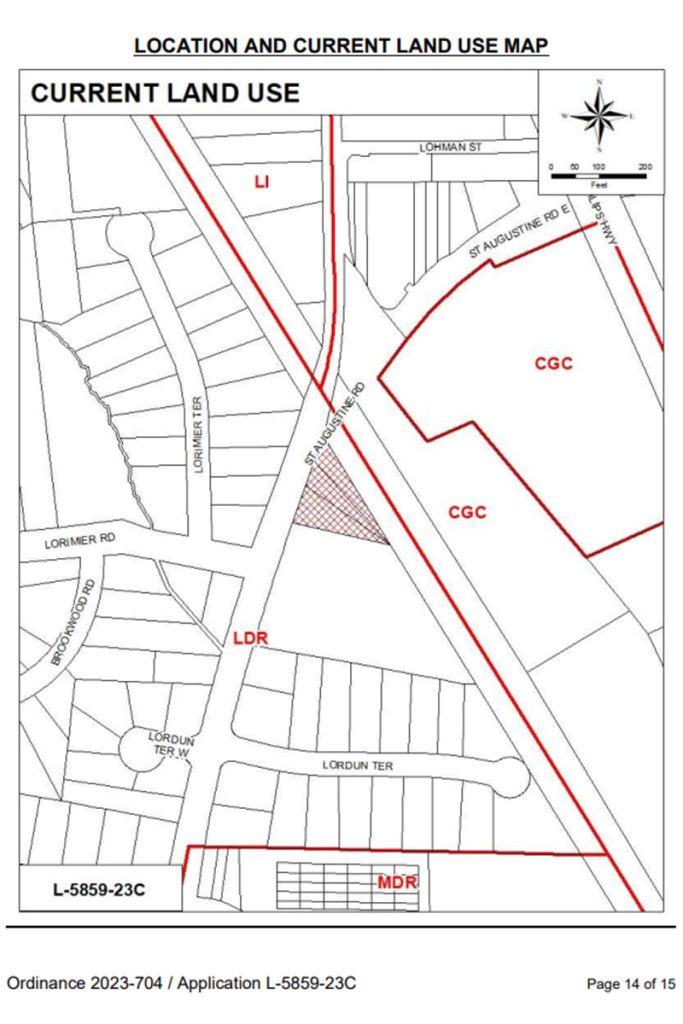Historic Cemetery Raises Grave Concerns for Rezoning

A proposed rezoning request for a parcel of land in San Marco continues to spur community conversations and opposition.
The parcel in question is just under half an acre immediately adjacent to the historic Philips Craig Swamp Cemetery, which dates back to the 1840s. The proposed request is to change the Land Use Designation from Low Density Residential (LDR) to Industrial Business Park (IBP) to develop the land for a proposed single-story office building with rear warehouse storage.
The legislation, along with two accompanying administrative deviations, was introduced last October. It went before the Land Use and Zoning (LUZ) Committee on Jan. 17.
Community concerns

In November, the San Marco Preservation Society (SMPS) submitted a letter to the LUZ Committee opposing the proposed rezoning and its deviations.
The letter read, in part, “Up-zoning this property from residential to industrial would reclassify this property from one of the lowest density uses to one of the highest; this change would be inconsistent with the spirit of transition of density encouraged by urban planning and our City’s Comprehensive Plan.”
SMPS also expressed resiliency and drainage concerns, as the property, a forested pie-shaped parcel of land nestled between the railroad tracks and the historic cemetery, is low-lying.
“The property itself dips noticeably in topography-almost 10 feet lower than the adjacent cemetery,” SMPS continued in its letter.
“There’s a resiliency issue where flooding could be exacerbated for the existing homes and potentially damage the cemetery because you would have increased water runoff into the cemetery therefore it may become more difficult for them to even maintain a grass in the area, it’s hard to know for certain,” said SMPS Resiliency and Sustainability Committee Chair Logan Cross.
SMPS Board Member Grace Davis said her preference would be to leave the plot of land undeveloped.
“I would say the preference is to leave it, preserve it as is,” she said. “No need to tear down nature unnecessarily and pave it over. I think with respect to the neighbors and the community, I think the best path would be to leave it as is.”
Approving the use “in concept”
At the Jan. 17 LUZ Committee meeting, attorney Cyndy Trimmer, on behalf of the applicant, stated that even if the property owner were to obtain approval for the rezoning request and administrative deviations, he still would have to move through the permitting process, during which any potential drainage issues or the like would be “fully vetted.”
“This is kind of the open stages of, ‘Is the concept of the use something that we could get behind?’” she said.
Still, Trimmer did address the drainage concerns, pointing out the existence of “a natural divide” between the property and the cemetery. Additionally, to concerns expressed by SMPS of future uses of the property, Trimmer said that due to the size and unique shape of the property, anyone seeking to repurpose the building, expand it or raze it to later build something new would have to come back before city council for the necessary approvals.
“The site really does naturally confine anything that could happen in the future on the property,” she said.
Trimmer and her colleague Michael Sittner both discussed three proposed conditions to which the property owner agreed “to directly meet the concerns with compatibility with the existing neighborhood.”
Those conditions, as stated by Sittner, are:
- “We agree to provide or preserve a minimum of five trees within 25 feet of St. Augustine Road, at least two of which will be shade trees. The remainder of the landscaped area along St. Augustine Road, excluding driveways, shall be landscaped with trees, shrubs, ground coverage, grass or mulch except that mulch shall not exceed 25% of the total landscaped area;”
- “We agree to have a maximum of one rollup garage door, which will be located on the southeastern façade facing the railroad. The rollup garage shall not exceed 12 feet in height;” and
- “The third proposed condition is applicant agrees the office’s architectural treatment will wrap the northwest façade of the building facing St. Augustine Road.”
Carlucci’s Conditions
As the district councilmember, Joe Carlucci played a prominent part in the LUZ meeting’s conversation surrounding the proposed development and the parcel of land upon which it would be built. Early in the discussion, he stated he’d completed his own evaluation of the site, including, he said, meeting with the City’s stormwater department head.
“He pretty much walked the whole entire parcel,” Carlucci said. “There were no red flags to him at all, so that gave me a lot of ease with it because when you look at it, it’s very low. And he gave me examples of how that can be rectified and how the water would not flow into the cemetery.”
Carlucci said he had reached out to the City’s chief resiliency officer, Anne Coglianese, for her input on this project, although he said there’s no report back from her regarding this.
“For this site, there was no immediate urgency for her to respond back, so I think we’re good there,” he added.
Pertaining to further concerns regarding the cemetery and site uses, Carlucci said, “I think we can curb that in in the administrative deviation portion of it.”
During the conversations surrounding the two administrative deviations, Carlucci presented a pair of his own conditions to the applicant.
The first was a limitation on how much of the building could be devoted to warehouse storage space. According to Trimmer, conversations surrounding usage space “have always been half-and-half.” Carlucci proposed a maximum 45% cap on the warehouse storage space, which Sittner said they could accept.
The second – more of a “concession” than a condition, Carlucci explained – was that should the development fail moving through the permitting process, the applicant would be okay with the city introducing legislation to rezone the property back to its original designation as LDR “because of all the concerns we heard about the drainage.”
Both Sittner and Trimmer said they could not agree to that, with Trimmer stating that was something “in all of the cumulative careers of my team no one has ever been asked.”
“Not to say that [the property owner] wouldn’t do it, it’s just this isn’t appropriate for this forum to do that,” said Trimmer. “If for any reason it did fail, he would like the opportunity to look at all of the other alternatives that might exist in consultation with the councilman and the planning department at that time, rather than commit him to one specific path, if for any reason this failed.”
“The issue I have with that is we’re here to represent the community the best way possible, to keep the integrity of the community, the zoning in general for this part of the railroad,” Councilmember Raul Arias said in response. “Clearly the community doesn’t want this. I, personally, I’m not on board anymore.”
“I have to do what I believe is right not only for the community but for this parcel and I think that’s what we’re going to do going forward,” Carlucci added.
“One of the biggest concerns for myself and the community was the drainage and they didn’t want to budge on the condition for drainage and that’s not something that I’m willing to budge on at all,” Carlucci later said in an interview. “Whatever they come back with, it has to be absolutely –it has to be risk-free from a drainage standpoint and that’s what my goal was [at the meeting] was to create kind of a risk-free situation for the historic cemetery, for the surrounding neighborhoods to make sure drainage would not be an issue.”
Ultimately, Trimmer asked to defer the final administrative deviation, which the committee agreed to do. To keep the three bills together, the committee also moved to reconsider and defer 2023-0704 and -0705.
All three will return to the LUZ Committee on Feb. 6.
The Resident News will continue to report on the situation as it develops.
By Michele Leivas
Resident Community News







